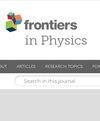NUOVA OFFICINA ASSERGI: a novel infrastructure for the production of cryogenic and radiopure Si-based photodetectors
IF 1.9
3区 物理与天体物理
Q2 PHYSICS, MULTIDISCIPLINARY
引用次数: 0
Abstract
The NUOVA OFFICINA ASSERGI (NOA) is a new facility for the production and integration of large-area silicon photodetectors operating at cryogenic temperatures. Silicon photomultipliers are proving to be a promising technology for next-generation experiments searching for rare events in underground laboratories. New photosensor technology with high performance at cryogenic temperature has been developed by Fondazione Bruno Kessler (FBK) and integrated at Laboratori Nazionali del Gran Sasso (LNGS) into large-area optical units, thus opening the frontiers toward the realization of scalable liquid argon experiments probing dark matter. The massive production of such detectors is now feasible in NOA, a clean room of 421NUOVA OFFICINA ASSERGI:生产低温和辐射纯硅基光电探测器的新型基础设施
NUOVA OFFICINA ASSERGI(NOA)是在低温条件下生产和集成大面积硅光电探测器的新设施。硅光电倍增管被证明是在地下实验室进行下一代罕见事件搜索实验的一项前景广阔的技术。布鲁诺-凯斯勒基金会(FBK)开发了在低温条件下具有高性能的新型光传感器技术,并在大萨索国家实验室(LNGS)将其集成到大面积光学单元中,从而为实现探测暗物质的可扩展液氩实验开辟了前沿。NOA 是一个 421 平方米的无尘室,可在无氡模式下运行。在 LNGS 调试和运行的 NOA 拥有最先进的封装设备和电子测试设施,用于在粉尘控制环境中集成硅器件。基础设施布局分为两个实验区:一个用于生产电子设备和低温测试,另一个用于操作大型探测器装置。NOA 设施可与氡消减系统一起运行,使其成为在无氡环境中封装和测试基于 SiPM 的光传感器以及组装探测器组件的独特设施。因此,NOA 支持在 LNGS 部署地下实验,并支持开发用于搜索暗物质和无中子双贝塔衰变等罕见事件的新技术。
本文章由计算机程序翻译,如有差异,请以英文原文为准。
求助全文
约1分钟内获得全文
求助全文
来源期刊

Frontiers in Physics
Mathematics-Mathematical Physics
CiteScore
4.50
自引率
6.50%
发文量
1215
审稿时长
12 weeks
期刊介绍:
Frontiers in Physics publishes rigorously peer-reviewed research across the entire field, from experimental, to computational and theoretical physics. This multidisciplinary open-access journal is at the forefront of disseminating and communicating scientific knowledge and impactful discoveries to researchers, academics, engineers and the public worldwide.
 求助内容:
求助内容: 应助结果提醒方式:
应助结果提醒方式:


